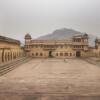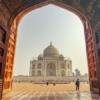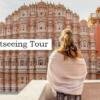Indian art forms and craft are as varied as patchwork. Indian painting styles have distinctive beginnings and histories, which add to their allure. Indian art forms come in a wide variety, as this comprehensive list of styles demonstrates, and each region of India has contributed to the country’s rich cultural legacy.
They all primarily feature religious epics of Gods and Goddesses, yet they are all distinctive, laudable, and unmatched in their own power. They used to be created on canvas or cloth using natural dyes and colors created from earth, mud, leaves, and charcoal, giving them an antiquated, nostalgic feel. Here are 12 traditional, rich art forms of Indian painting techniques that are still used in some regions of the nation.
1. Madhubani
The traditional painting genre known as Madhubani Painting, also known as Mithila Painting, originated in the Bihar area of Madhubani. It is among the most popular and esteemed types of famous artform of India . In Bihar, it has been done for many generations. These pieces of art, which were made with rice flour, twigs, and natural hues, have attracted attention from around the world. Others show regular people going about their daily lives, while some of them are dedicated to gods and goddesses. The range of themes is what makes Madhubani a classic art form.
2. Miniature Paintings
These paintings stand out for their tiny size, rich detailing, and sharp expressions. Miniature paintings are a Mughal art form that dates back to the 16th century and were particularly popular during the eras of Shah Jahan and Akbar. Rajputs later adopted it, and today it is widely practiced in Rajasthan. The paintings, like other types of art, feature religious motifs and epics.
Contact us to explore the Jaipur art walk Tour.
3. Warli
It was created by the Warli people of the Western Ghats circa 2500 BCE, and is undoubtedly one of the oldest art styles in India. It mostly consists of the use of squares, triangles, and circles to construct a variety of forms and symbolises events from daily life, such as festivals, fishing, and hunting. It is distinguished by its distinctive human shape, which is made up of a circle and two triangles. On a background of red ochre or black, white shapes are used to create each artwork.
4. Kalamkari
In India, kalamkari, which literally translates to “drawings with a pen,” comes in two varieties: Machilipatnam, which is derived from Machilipatnam in the state of Andhra Pradesh, and Srikalahasti, which is derived from Chitoor in the same region. The latter uses a pen to create free-flowing artwork on cloth, whereas the former refers to block-printed art. Today, sarees and ethnic apparel are decorated with kalamkari art, which represents everything from nature and wildlife to epics like the Mahabharata or Ramayana.
5. Kalighat Paintings
It was created in Bengal in the 19th century, in Kalighat. At the time, revolution against the British seemed like a thrilling possibility. Originally depicting Gods and Goddesses, these paintings on fabric and pattas later turned towards social reform. The art was distinguished by immaculate strokes, brushwork, and straightforward but striking drawings, all created using inexpensive paper, paint colors, squirrel hair brushes, and color pigments. It aimed to educate its audience about social situations by showing priests with ‘unchaste’ ladies, affluent zamindars enjoying wine with women, and sloppy police babus.
Contact us to explore the Agra art walk Tour.
6. Patachitra
These paintings, which are cloth-based scrolls from West Bengal and Odisha, have bold, angular lines and portray epics, gods, and goddesses. Since there was no documented differentiation between an artist and a sculptor in the fifth century, it is believed to have started in sacred centres like Puri and Konark. The Mughal era has a strong influence on the dress style represented in the paintings, which makes this art form distinctive.
7. Tanjore
The Thanjavur Nayakas, who originated in the South, supported the creation of Tanjore or Thanjavur paintings about 1600 A.D. The use of gold foil, which glitters and gives the piece a surreal look, can be used to identify a Thanjavur painting. The devotion to gods, goddesses, and saints is depicted in these panel paintings on wooden boards. It incorporates elements of both European and Maratha art into its styles.
Take Handicraft/Art tour In Delhi with Local guide.
8. Phad painting
Phad is a traditional Rajasthani scroll painting from India that depicts tales of legendary romance, valiant battles, and regional deities on horizontal cloth scrolls using vibrant orange, red, and yellow tones. Phad painting, also known as phad, is a form of folk art that is popular in the Indian state of Rajasthan. Phad Painting brilliantly depicts multiple tales in a single work while expertly upholding the aesthetics of artistic expression. Traditionally, this kind of painting is done on a long canvas or piece of fabric called a phad.
9. Pichwai painting
In the Krishna temples in Nathdwara, wall hangings depicting stories about Lord Krishna’s life were made in the Picchwai style. The most vibrant and sophisticated works of art have hidden symbolism in the form of picchwais. This recognized kind of religious art has been passed down from generation to generation and is an excellent illustration of spirituality in art. 2011’s National Award was to Kalyan Mal Sahu for his outstanding contribution to Pichwai art.
10. Rajput Painting – Rajputana
Rajput art forms, which flourished in the 18th century in the royal courts of Rajputana, depicted scenes from the Ramayana and Mahabharata. These paintings’ colors were made from materials such as gold, silver, valuable stones, and plants. This was not a simple task, and it may sometimes take weeks to complete.
11. Gond Painting
Gond paintings, Madhya Pradesh-based forms of Indian art, are mostly characterized by animals and birds. The Gondi tribe of central India is the originator of these vivid paintings made with a succession of deftly placed dots and dashes.
Historically, colors came from organic materials including cow dung, plant sap, charcoal, colored mud, flowers, and leaves. Today, Gond painters paint on paper and canvas with professional water-based paints.
12. Picchwai
In Nathdwara’s Krishna temples, wall hangings behind the main deity are where the picchwai art form first appeared. At first, the artwork told tales involving Lord Krishna. But as the Picchwai art style has been more commercialized, secular elements have also been added.
Conclusion
This collection art form of India would have aided you in understanding the various styles of Indian art paintings, which contribute to our culture’s fame and wealth.
Latest Blog: Handicrafts in Agra






